Over the past years, I have found myself again and again struggling with one particular question: how do we describe, in clear and precise terms, what German horse people have come to call Trageerschöpfung? The word is untranslatable, the concept only vaguely defined, and yet the cluster of problems it points to is becoming increasingly common in horses everywhere.
For a long time, I experimented with translations, never quite satisfied. But now, after many conversations with colleagues abroad, I believe we finally have a term that works — one that is both accurate and internationally accessible. It is time to introduce it and to explain why it matters.
.
Progressive Structural and Functional Decline – Rethinking the Concept of Trageerschöpfung from a Biotensegral Perspective
The German term Trageerschöpfung
was coined by Tanja Richter and first described in her book Illusion Pferdeosteopathie. Literally translated, it means “carrying exhaustion” and was introduced as an umbrella term for a cluster of symptoms increasingly seen in horses since the early 2000s – so common at the time that it seemed almost epidemic. Richter used it to group a wide range of signs all linked to a decline in the horse’s ability to carry itself and its rider with stability, often accompanied by premature wear and tear.
The challenge is that the literal meaning of Trageerschöpfung
implies fatigue – and therefore recovery through rest – when in fact the underlying process is not exhaustion in the conventional sense. What we are really looking at is a progressive loss of structural integrity and functional organisation, primarily driven by underuse or misuse of the body’s inherent capabilities in daily life and training.
Other terms have been used in both German and English contexts: “topline syndrome” narrows the focus to visible changes in the horse’s outline, while “myofascial dysfunction” frames it as a localised, therapy-repairable problem. None of these terms reflect the systemic nature of what is actually happening – a body-wide breakdown in functional organisation that ultimately affects movement, metabolism, and even respiratory health.
The Biotensegral Perspective
Biotensegrity – the structural organisation principle of living systems – views structure and function as inseparable and mutually reinforcing. A resilient structure enables functional movement; functional movement strengthens the structure. If this cycle is interrupted for long enough, structural and functional deterioration progress together.
From this perspective, the process we are talking about is not a localised “topline” problem, but a global functional breakdown: an ongoing failure to use the available functional potential due to unsuitable management, inappropriate training, poor hoof care, and/or pain.
Self-Organisation as the Key to Rehabilitation
The central resource for recovery is the body’s biotensegral self-organisation capacity – its ability to bring itself, through interaction with the environment, into a stable and functional state. This capacity must be addressed in both daily life and training.
When horses are given the opportunity to activate their functional organisation in real-world movement situations, structure and function can once again develop together. In most cases, this progressive structural and functional decline can be reversed – often with visible change within the first days. It becomes irreversible only when critical structural components are permanently damaged, such as through a tenotomy (surgical cutting of a tendon). Such interventions should be regarded as palliative measures: they destroy key elements of the tensegral structure and make full restoration of self-organisation impossible.
Why We Need a New Term
This is why I propose the deliberate introduction of the term Progressive Structural and Functional Decline in the context of equine health. It describes with precision what is actually taking place: a systemic deterioration affecting both structure and function, understood internationally and free of misleading connotations.
While the term Trageerschöpfung
has mainly circulated within the therapeutic community, the new concept of Progressive Structural and Functional Decline is intended to go further. It offers a framework that can be useful not only for therapists, but also for veterinarians, researchers, farriers, hoof trimmers, trainers, and riders. In this sense, the term holds the potential to bridge worlds that too often remain separate — creating a shared language for understanding and addressing a systemic problem in equine health.
By replacing vague or inaccurate terms such as Trageerschöpfung, “topline syndrome” or “myofascial dysfunction” with a clear, functional concept, we lay the groundwork for a global, system-oriented discussion on equine health – one that recognises the horse as a self-organising, living system and builds rehabilitation on that foundation.

